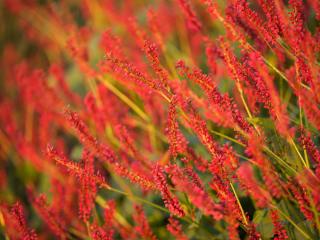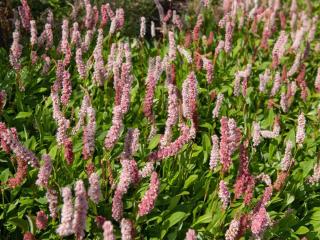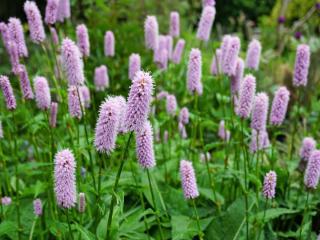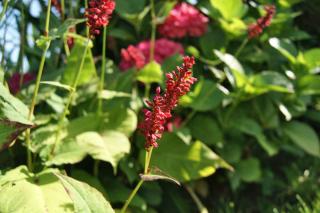

Persicaria is a genus with species that are so different that you’re certain to find one to match your needs!
Smart Smartweed facts
Name: Persicaria species
Formerly: Polygonum species
Family: Polygonaceae
Type: flower, perennial
Height: 8 to 12 inches (20 to 30 cm)
Exposure: full sun, part sun
Soil: ordinary, humus-rich – Flowering: summer and fall (species) – Foliage: evergreen
Smartweeds include a great number of plants. Some are annuals, others are perennials, yet others grow into vines. All in all, though, the species you’ll most often find in gardens are perennials.
Most appealing from the many features of Persicaria is its amazing diversity. There are hundreds of shapes and colors to chose from! Indeed, no two persicaria flowers look remotely alike. Perhaps the only thing they have in common is an incredible capacity to cover the ground, and their long-lasting blooming.
For some species, flowers stand tall for months atop slender, upright stems (P. capitatum). For others, the blooming is airy and ethereal, as is the case for P. campanulatum and P. weyrichii which has flowers that look like those of astilbe.
Foliage is often oval, more or less narrow depending on the species. Again, size varies greatly from one species to the next: under an inch long for some (3 cm) to over a foot (30 cm) for others.
A few species are easier to find than others. Let’s take a look at them here:
 Average height, this smartweed grows nearly 3 feet wide and tall (80 cm).
Average height, this smartweed grows nearly 3 feet wide and tall (80 cm).
From summer to fall, uncountable short stalks appear with lavender-like clusters of pink-red flowers.
Leaves are oval or cordate and turn a beautiful red-orange hue in fall before they drop off.
 Certainly the favorite of all, since it’s very common in many gardens. The Himalayan bistort is an evergreen species. It will keep its short, lance-shaped leaves during winter, though they’ll take on a lovely bronze sheen in fall.
Certainly the favorite of all, since it’s very common in many gardens. The Himalayan bistort is an evergreen species. It will keep its short, lance-shaped leaves during winter, though they’ll take on a lovely bronze sheen in fall.
Flowers appear end of summer, forming dense clusters of red-pink flowers.
 Bistort knotweed is quite similar to P. amplexicaulis, but it’s a bit smaller.
Bistort knotweed is quite similar to P. amplexicaulis, but it’s a bit smaller.
The blooming is also a bit different, since the pale pink flowers appear at the beginning of sum mer instead of mid and end of summer.
→ Did you know?
Silver lace vine was long considered part of the Persicaria genus. Today, however, genetic analysis has moved the plant to another genus: Fallopia.
Though you’ll find Polygonum plants growing in all types of soil, there are two things that must be provided: proper drainage, and rather cool soil.
 This means that regarding exposure, best is to favor part shade, or eventually full sun, but in a spot that doesn’t get too hot.
This means that regarding exposure, best is to favor part shade, or eventually full sun, but in a spot that doesn’t get too hot.
Plant your smartweed preferably in fall to give your plant enough time to produce a root system capable of searching for cool water during drought.
Once you’ve found the right spot, follow these steps to plant your Persicaria:
Once it’s properly settled in, your smartweed flower won’t require much care. Nonetheless, you should know that most species grow into mounds that cover the ground well. This is great when you plant it atop a mound, but it might mean you have to control it if planted as an edge or in a flower bed. Keep the clump in check by removing stems around the rim of the plant.
If, despite your efforts, the Persicaria clump has grown too large, just pull it out in fall, divide it, and plant it back.
Eliminate wilted flowers at the end of fall.
The easiest way to create new smartweed plants is crown division. You can also cut offshoots out from the base of the clump.
If flowers are left to ripen, you can plant the seeds: they will germinate with a high success rate.
This endearing perennial comes in so many colors and shapes, you’re sure to find one to fit your needs. There’s bound to be a persicaria that’s perfect for:
Its abundant blooming lasts from the beginning of summer up to fall, and some varieties are even considered invasive because their spread is high-paced.
As for what companion plants fit it best, go for grasses. Shorter grass species will be better here, such as Pennisetum, a few specific types of Miscanthus, and/or Carex.
Dwarf Persicaria can be planted for ground cover and the resulting effect is remarkable.